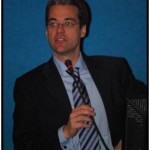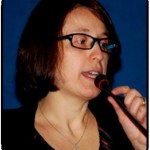A .I.G.’s (Associazione Italiana GIST) fourth national meeting was held at Fondazione IRCCS Istituto Nazionale dei Tumori (INT) in Milan on February 26, 2011. The focus of the meeting was, “What is GIST and How to Treat ItDr. Paolo Casali, head of the Sarcoma Department at INT, Milan, discussed the changes in the past ten years of care and treatment for patients with GIST and what is medically possible in the years ahead. Dr. Casali noted, as we look to the future, there are things that no one thought possible years ago with regard to medicine and GIST treatment. Collaborative efforts and initiatives between various groups are important aspects for oncology research including cooperative relationships with tissue banks. Patient associations play a vital role in the management of these tissue banks and the studies performed on the tissues.
 The meeting proceeded with a discussion from Dr. Alessandro Gronchi, surgeon at INT, on the
The meeting proceeded with a discussion from Dr. Alessandro Gronchi, surgeon at INT, on the  stages of GIST from diagnosis to treatment from the viewpoint of a surgeon. Dr. Elena Fumagalli, oncologist at INT, then explained the current issues of drug therapies and side-effects management of target therapy. During the second session, the group decided to expand A.I.G. meetings to include some GIST research centers in Italy via live conference call. This will enable A.I.G. to not only partner with these centers but also have the most up to date information on GIST research.
stages of GIST from diagnosis to treatment from the viewpoint of a surgeon. Dr. Elena Fumagalli, oncologist at INT, then explained the current issues of drug therapies and side-effects management of target therapy. During the second session, the group decided to expand A.I.G. meetings to include some GIST research centers in Italy via live conference call. This will enable A.I.G. to not only partner with these centers but also have the most up to date information on GIST research.
Meeting participants also included:
Dr. Guido Biasco, and Dr. Maria Pantaleo – University of Bologna, Policlinic Suor Orsola Malpighi
Dr. Silvia Gasperoni, AOU Careggi, Florence
Dr. Giuseppe Badalamenti, Policlinic P. Giaccone, Palmero
Dr. Raffaella Bracci, AOU Umberto I Torrette, Ancona
Dr. Bruno Vincenzi, University Biomedical Campus, Rome; and GIST Patients and family members.
Other topics discussed were: preclinical and translational research and the importance of GIST research centers and patient organizations involvement in GIST research. The clinicians were pleased to answer all of the patients’ questions regarding medical therapy in advanced stages of GIST, side-effects management, follow-up, the role of imaging, stress-management of GIST patients and approaches against resistance. The information provided by the clinicians was greatly appreciated by the audience.



